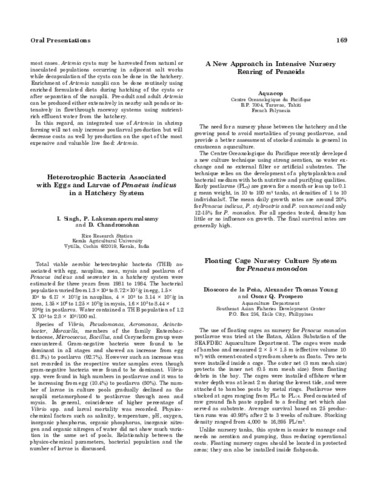A new approach in intensive nursery rearing of penaeids
- Global styles
- MLA
- Vancouver
- Elsevier - Harvard
- APA
- Help
Share
Abstract
The need for a nursery phase between the hatchery and the growing pond to avoid mortalities of young postlarvae, and provide a better assessment of stocked animals is general in crustacean aquaculture.
The Centre Oceanologique du Pacifique recently developed a new culture technique using strong aeration, no water exchange and no external filter or artificial substrates. The technique relies on the development of a phytoplankton and bacterial medium with both nutritive and purifying qualities. Early postlarvae (PL3) are grown for a month or less up to 0.1 g mean weight, in 10 to 100 m3 tanks, at densities of 1 to 10 individuals/ℓ. The mean daily growth rates are around 20% for Penaeus indicus, P. stylirostris and P. vannamei and only 12-15% for P. monodon. For all species tested, density has little or no influence on growth. The final survival rates are generally high.
Description
Abstract only.
Suggested Citation
Aquacop. (1985). A new approach in intensive nursery rearing of penaeids (Abstract only). In Taki Y., Primavera J.H. and Llobrera J.A. (Eds.). Proceedings of the First International Conference on the Culture of Penaeid Prawns/Shrimps, 4-7 December 1984, Iloilo City, Philippines (p. 169). Iloilo City, Philippines: Aquaculture Department, Southeast Asian Fisheries Development Center.
Type
Oral presentationISBN
9718511008



